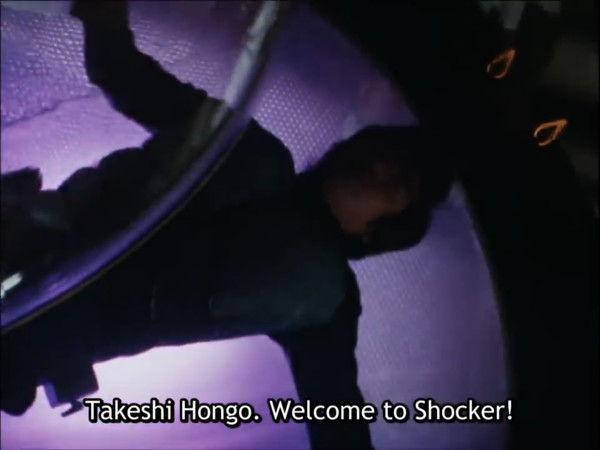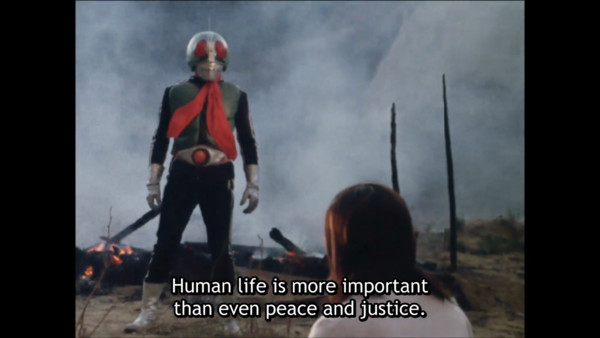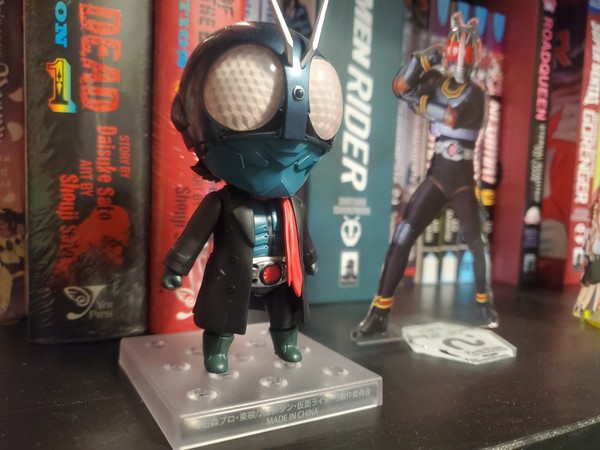How Kamen Rider Helped Me Recover from Trauma
by Jean-Karlo Lemus,Takeshi Hongo is Kamen Rider, a cyborg. He was modified by Shocker, an evil secret society that pursues world domination. Kamen Rider has pledged to fight against Shocker for the sake of freedom for all humanity.
When Kamen Rider began in 1971, viewers watched as the motorcyclist Takeshi Hongo (played by a young Hiroshi Fujioka) was run off the road by a group of mysterious people. He wakes up to find himself strapped to a table, his body already modified beyond recognition. He now navigates a world of cardboard, where his hands--redesigned to crush bone and metal—can no longer comfort a crying child or even handle a faucet without snapping the pipes.
As I set out to handle some errands one chilly morning in 2023, I found myself tackled to the road by a car. I never lost consciousness, but I similarly found myself strapped to a gurney in a body that was no longer my own. I now had to navigate a world where my own hands—only used for clacking away on keyboards or tapping buttons on controllers—were now incapable of grabbing or lifting a three-pound alligator plushie. Because painkillers are strictly monitored by hospitals, I would have to get used to the pain of a fractured humerus and a shattered elbow.

Much has been written about Shōtarō Ishinomori's anti-fascist themes in Kamen Rider--and rightfully so. The original Kamen Rider series was released in Japan during a time of much political strife, wherein there was an up-swell in authoritarian sentiment in Japan. But Kamen Rider—the hero, not the series—also makes a point to underline that what he fights for is humanity. Indeed, humanity is at the core of Kamen Rider's existence. While his red-eyed helmet and green armor are meant to evoke the humble grasshopper, the tear-shaped dots under his helmet's eyes--originally designed so that the suit-wearer could actually see outside of the bulky helmet while performing stunts--are meant to evoke the tears Kamen Rider can no longer shed. Shin Kamen Rider introduced the idea that transforming into his helmeted form numbs Takeshi Hongo to his violence and brutality in battle. Thus, he only transforms to fight Shocker's Augs—what little humanity he has left, he clings to desperately. The original series was far more practical: Kamen Rider needed constant airflow powering the turbine on his belt to maintain his herculean strength. Regardless, Takeshi Hongo ceaselessly endeavored to protect the smiles and humanity of those around him. "Human life," he famously said, "is more important than justice."

To be human is to be flawed, weak, endlessly tempted. There's no telling which of Shocker's minions was forcefully recruited like Hongo and who among them willingly sacrificed their humanity in a bid for power. Shin Kamen Rider's Augs all joined SHOCKER in the name of finding some form of "happiness," but that happiness is fleeting, based only upon selfishness and causing suffering in others. Contrast that with Takeshi Hongo. Because he had escaped Shocker before they could finalize his brainwashing procedure, he still has his free will. As a side effect, he also feels pain as he fights Shocker's monstrous cyborgs. Every blow, explosion, bolt of lightning, or bodyslam inflicted on him is one he feels just as much as when he was an ordinary human. But in the name of making sure other people don't have to suffer that pain, in the name of protecting other people's happiness... he fights. As Kamen Rider actor Hiroshi Fujioka put it, "When you're doing something for yourself alone, you're not much. But when you are doing something for someone else, that brings a lot of extra power and capability to the human body."
This heroic willpower took on a new context when, ten episodes into filming, the leading actor, Hiroshi Fujioka, broke a leg performing a riding stunt during filming. Fujioka was written out of the series in the meantime, necessitating Takashi Sasaki to take up the role of Hayato Ichimonji, Kamen Rider 2. As Fujioka would be unavailable to perform for six months, Toei even suggested killing Takeshi Hongo. Producer Toru Hirayama protested the decision, claiming, "Do you want to crush the dreams of children?!" It was those very same children that Fujioka kept in mind as he endured his rehabilitation, eventually returning to the show and standing alongside his new co-star Sasaki as the Double Riders. "I never thought that I would not go back to the show. I always thought that I would go back and continue inspiring children," Fujioka said in an interview. "I got a lot of courage from the children. And so I wanted to give some of that back to them. That's what really motivated me." That spirit bled into Fujioka's performance and would go on to inspire generations of children over the decades. This season's Tojima Wants to Be a Kamen Rider might start out playing it up for silly points, with a protagonist so in love with the franchise that he'd rather throw out all of his merch on his own than think of others throwing it away after he dies alone. But even that gives way to Tojima finding his valor in the name of helping people around him.

I'd been a Kamen Rider fan for ages when I had my accident. I had first become aware of it reading the pages of Electronic Gaming Monthly, where Hideo Kojima namedropped its villains as the inspiration behind the Cobra members exploding upon their deaths. I was already a fan of Japanese special effects shows, having watched Power Rangers and Godzilla all my life, and finding more Japanese media inspired by Kamen Rider like Viewtiful Joe only cemented my interest. I scrounged the Internet for subbed episodes of Kamen Rider Kuuga or Kamen Rider Stronger while I was in college. I dreamed of importing a deluxe replica of a Kamen Rider belt while I worked on my Master's degree, where subtitled episodes of Kamen Rider Gaim and Kamen Rider Drive were the only entertainment I consumed between reading scholarly essays from Donna Haraway or Ferdinand de Saussure. When I moved away from home and struggled to find a job, Kamen Rider Ghost and Kamen Rider Amazons were there. As I struggled to establish myself in Portland with no friends or support network, Kamen Rider Zero-One kept my hopes up. The stories of Hiroshi Fujioka enduring his broken bones and returning to the show were just trivia one gathered through watching all these shows about kung fu bugmen--heroic endeavors from a dedicated actor, but not something I thought much more about. I could just appreciate these stories of young men and their motorcycles, kicking fascists, monsters, and fascist monsters until they exploded.
And then I got hit by a car.

Strapped to a stretcher to avoid aggravating any potential neck injuries (which I thankfully didn't have), I was forced to stare at the ceiling and hope friends could come to my aid so as not to be alone. The adrenaline wore off shortly; while painkillers were readily offered, it took a bit of convincing to get me to accept them. My left elbow was shattered, and my right humerus had snapped. Both arms needed surgery—but until then, I had to be put under to set my bones. "Try to think of someplace nice," they told me. Well, thinking of the beaches back home wasn't quite enough. But as the ketamine took hold and dumped me into a cacophony and color, it helped to think of Takeshi Hongo.
It would nevertheless take a few days before I could be accommodated for surgery, after which it would be a long process as arms that were no longer entirely mine healed around metal screws and plates. In the meantime, all I could do was wait. I was used to being able to scratch my nose or rub my eyes; now, I could barely pick up my cell phone if it fell off my belly and onto my side. My left hand was completely numb, and swelling grotesquely in the wake of healing; I lived in terror that it'd never regain the dexterity to type. Dignity had to be shelved while I was incapable of taking care of myself. There was nothing to do but wait, haunted as I was by fears of what would come next. How much could I heal afterward? How long would the pain last? What if it never goes away? What if I do heal—and become someone I'm not in the process? Using what little dexterity I had in my right arm to scroll through the Internet was about the most I could do to distract myself. I don't remember where or how, but in my scrolling, I came upon an image of Kamen Rider... and I just started crying.
Saw a picture of Kamen Rider. Started crying. I have a long road to recovery for both my arms. There's going to be a lot of pain. I'm not a cyborg. For once, I feel fear.
— Mouse in the House (@mouse_inhouse) November 10, 2023
I'll try as much as I can. Hongo would want me to. I have my heart and kindness. I can't let fear win. pic.twitter.com/vNGimVlS9o
Yes, there was going to be pain. I'd have to manage it all as best I can, and learn to operate around it while my arms healed. I was going to have to relearn to use my arms, to say nothing of relearning how to get up or kneel without using them. Eventually, there would be rehab. And again, there was going to be pain: stabbing pain in both arms as I fell asleep at night, gnawing pain as I woke up in the morning, the slow onset of dread and discomfort as I found myself in that awkward positioning between painkiller doses. And the weight of it all scared me. I'd done difficult things before; I'd moved away from my family, I'd been through a car crash, and I'd graduated with a Master's degree. I could move while under pressure and endure things. But pain was new. And I was scared of it.
But once I realized I was afraid, I was relieved. Because being afraid of something is only the first step towards overcoming it, isn't it? Being afraid meant I was alive. Fear meant there was more I wanted to do and keep, and more that I didn't want to lose. If there's stuff you want to do and protect, obviously, you need to go ahead and protect it. Being afraid doesn't mean you can't do it. Being afraid means you've only just realized the shape of the thing. And pain... well, I was still alive enough to feel pain. And if I'm alive enough to feel pain, I'm alive enough to face it. It was just that simple. It's what Takeshi Hongo would say. And even if Takeshi Hongo wasn't real... Hiroshi Fujioka was. Fujioka was able to overcome his accident. I was under the impression at the time that he had broken both legs (he only broke one). But if Fujioka could recover from his broken legs and still ride the Cyclone—still come back as Takeshi Hongo... well, I already had a literal leg up on him. Arms can't be that much harder to heal than legs, right? Especially not with fifty years of medical advancements, right?
So there it was. I had my opponent. I had friends and coworkers watching over me. All I had to do... was the same thing Kamen Rider did. Because even if being a cyborg hurt, even if his life would never go back to normal... Takeshi Hongo kept on. This wasn't going to be a piece of cake... but it was doable. That was enough.
Weirdly, the surgery was the easiest part. The healing from the surgery, a little less so, but manageable. But it was here that I had to get to work, finding ways to get out of bed without using my arms and walking around the hospital floor to recondition myself. Eventually, I'd be transferred into skilled nursing, where I'd set to work training myself to relearn basic self-care. The pain was there. It stuck around for a while after I was discharged. It took a while longer for me to regain a proper range of motion with my right arm. But if Kamen Rider could do it...
The pain eventually went away. I dreaded the onset of winter, worried that the weather would make my new implants (read: screws) ache. Oddly, that never happened. I've regained the ability to type; while my left hand isn't as strong as it used to be, it's still dexterous. And I've lost some degrees of motion with my right shoulder. In the Kamen Rider manga, intense mood reveals Takeshi Hongo's medical scars across his face; my medical scars on my arms are still visible, along with a bit of a scratch on my forehead from when my face hit the pavement. But it's with no small amount of awe that I look back and realize that I overcame—and I'm still me. Materially, I was as lucky as I could ask for--I didn't lose even half of what I could have lost from all this. And if anything, it's made my appreciation for Kamen Rider stronger. On many levels, Hiroshi Fujioka's performance as Takeshi Hongo is a story of survival and endurance. But above all else—it's a story of hope. Loss can be overcome. Pain can be overcome. Fear can be overcome. That's what it means to be human. That's why being alive is precious.

Kamen Rider means something different to me now. Whether it's Takeshi Hongo in his smart blazer walking off into the sunset, or Minami Kotaro shedding tears over his brother, or Shoma Inoue shouldering the pain of knowing his true form strikes fear into the hearts of those he protects, I take solace in seeing these Riders stand tall in the end. Their pain echoes with mine, but so do their victories. And it's a pain that I've come to see many other Kamen Rider fans understand and empathize with. I've spoken with a few Kamen Rider fans at local conventions, all astounded at my recovery and who nod knowingly when they hear my story. Kamen Rider is a guy in a bug suit kicking things in a quarry... but when the squibs die down, he always turns back into a person. No matter what the source of a Rider's power—cybernetic implants, magic, disease, misfortune... it might alter your body, but it can't take away what makes you, you.
While Takeshi Hongo started his journey to end SHOCKER alone, he soon found not only a partner in the form of Hayato Ichimonji, but five other Riders. Together, the Seven Legendary Riders became mentors to newer Riders. Even now, when Kamen Rider appears before his newer Heisei- or Reiwa-era underclassmen, he's looked to as their senior—their mentor, and the example they live up to. There's no loneliness as a Rider; it's a hard road, but it's a road traveled with friends, allies, those who stumbled across your path, or those who simply chose to follow in your footsteps. I am not the only person who's been hurt, and I won't be the last. Kamen Rider taught me to endure, that pain could be overcome, and that things would work out--it's on me to let people know their pain can also be overcome. You are not weak for feeling pain, and you are not weak for stumbling. You can stand back up, and you can overcome. You're not alone. None of us is.

discuss this in the forum (1 post) |